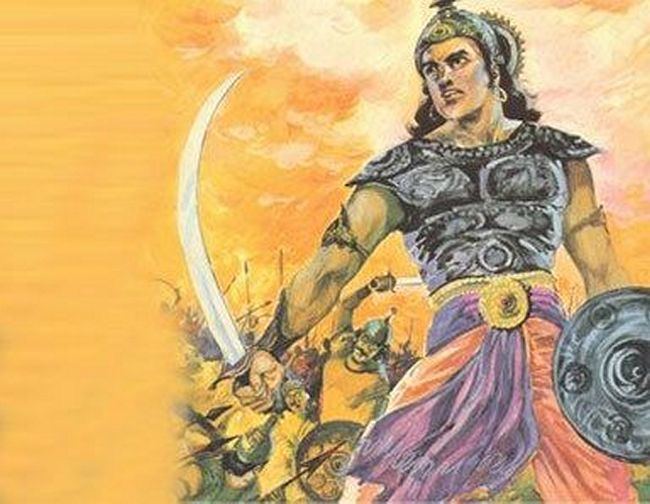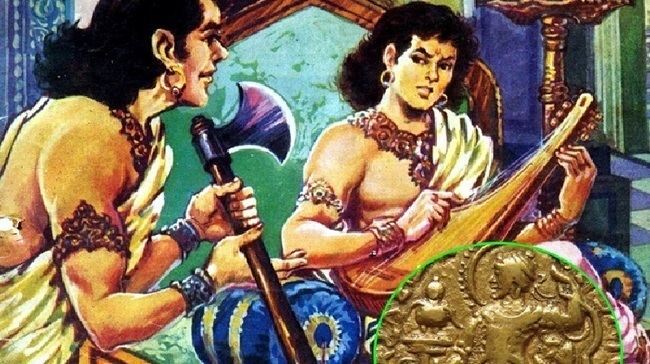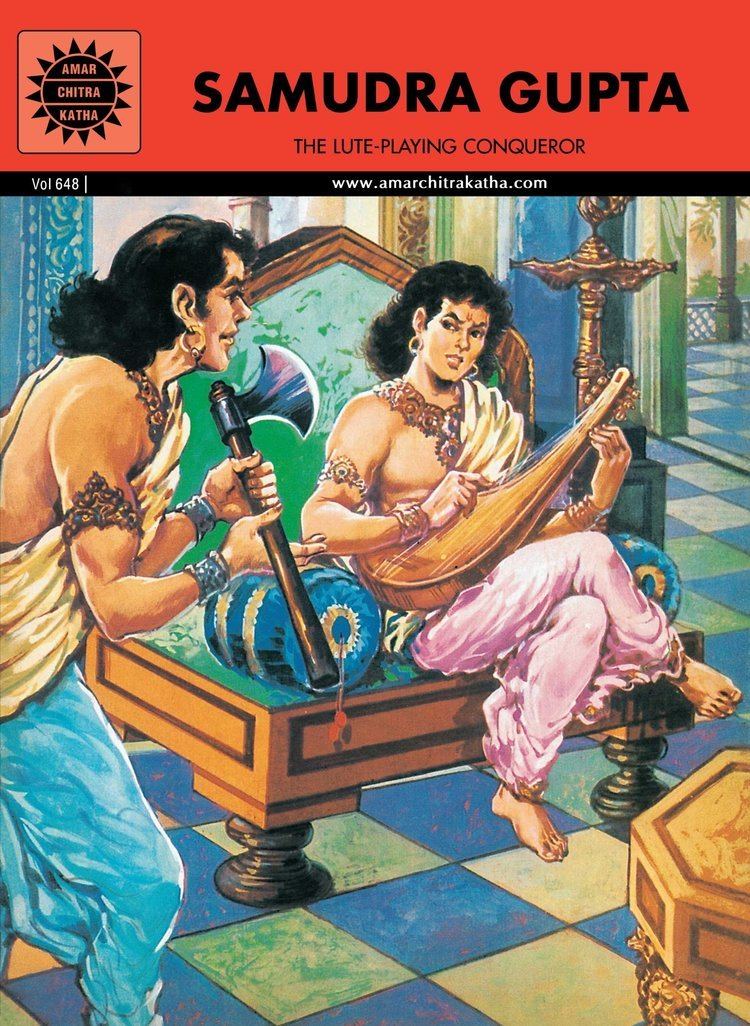Reign c. 336 – c. 380 CE Spouse Dattadevi Died 380 AD | Father Chandragupta I | |
 | ||
Parents Chandragupta I, Kumaradevi Children Chandragupta II, Ramagupta Similar Chandragupta II, Chandragupta I, Chandragupta Maurya, Kumaragupta I, Skandagupta | ||
Samudragupta s prashasti
Samudragupta (r. c. 335 – c. 380 CE) was the fourth ruler of the Gupta Empire and the son and successor of Chandragupta I. His rule was one of expansion marked first by the conquest of his immediate neighbours and then by campaigns to the east and the south where chiefdoms and kingdoms were subdued and forced to pay tribute to him. Much of the knowledge of Samudragupta's military exploits comes from the Allahabad pillar of Ashoka which includes a prashasti (a eulogy) extolling the deeds and virtues of the Gupta emperor. Going by the inscription, Samudragupta exerted direct or indirect control over much of the Indian subcontinent stretching from kingdoms in Nepal and the Punjab in the north all the way to the Pallava kingdom at Kanchipuram in the south-east.
Contents
- Samudragupta s prashasti
- Samudragupta
- Early life
- Samudraguptas Conquests
- Policy of Matrimonial Alliance
- Coinage
- Patronage
- Succession
- References
Samudragupta was the son of Chandragupta I and the Lichchhavi princess, Kumaradevi. He is believed to have been his father's chosen successor even though he had several elder brothers. Therefore, some believe that after the death of Chandragupta I, there was a struggle for succession in which Samudragupta prevailed. It is said that Samudragupta became the ruler after subduing his rival, Kacha, an obscure prince of the dynasty.

Samudragupta is depicted on his coins both as a muscular warrior flaunting the "marks of hundreds of wounds received in battle" as well as a poet and a musician. His reign marked the beginning of what is popularly referred to as the golden age of Indian history, a period where the arts and architecture flourished under the patronage of the Guptas. While his son, Chandragupta II, is generally considered Samudragupta's successor, according to the Devi-chandra-gupta, a play wrought a couple of centuries later, Ramagupta acceded to the throne first before being overthrown by his brother, Chandragupta II.

Samudragupta
Early life

Chandragupta I, a Magadha king, was the third ruler of the Gupta Dynasty and married a Lichhavi princess, Kumaradevi. This enabled him to gain a hold over the Ganges river-basin, the main source of North Indian commerce. He ruled from his capital at Pataliputra for about ten years in north-central India with his son, Samudragupta, as an apprentice.
After his death, Samudragupta assumed the throne and did not rest until he had conquered almost the whole of India. His reigning period may be described as a vast military campaign. To begin with, he attacked the neighbouring kingdoms of Ahichchhatra (Rohilkhand) and Padmavati (in Central India). He conquered the whole of Bengal, some kingdoms in Nepal and forced Assam to pay him tribute. He absorbed some tribal states like the Malvas, the Yaudheyas, the Arjunayanas, the Abhiras and the Maduras. The rulers of what is now Afghanistan and Kashmir were also added to the empire.
Samudragupta's Conquests
The beginning of Samudragupta's reign was marked by the defeat of his immediate neighbours, Achyuta, ruler of Ahichchhatra, and Nagasena. Following this Samudragupta began a campaign against the kingdoms to the south. This southern campaign took him south along the Bay of Bengal. He passed through the forest tracts of Madhya Pradesh, crossed the Odisha coast, marched through Ganjam, Visakhapatnam, Godavari, Krishna and Nellore districts and may have reached as far as Kancheepuram. Here, however, he did not attempt to maintain direct control. After capturing his enemies he reinstated them as tributary kings, an act which is a testament to his abilities as a statesman. His ambition was inspired by becoming "Raja Chakravarti" or greatest emperor and "Ekrat", undisputed ruler. In the North, he adopted the policy of "Digvijaya" which meant the conquest and annexation of all territories. In the South, his policy was "Dharma Vijaya" which meant conquest but not annexation.
Samudragupta was chosen as emperor by his father over other contenders and apparently had to repress revolts in the early years of his rule. On pacifying the kingdom, which probably then reached from what is now Allahabad (in present-day Uttar Pradesh state) to the borders of Bengal, he began a series of wars of expansion from his northern base near what is now Delhi. In the southern Pallava kingdom of Kanchipuram, he defeated King Vishnugopa, then restored him and other defeated southern kings to their thrones on payment of tribute. Several northern kings were uprooted, however, and their territories added to the Gupta empire. At the height of Samudragupta’s power, he controlled nearly all of the valley of the Ganges (Ganga) River and received homage from rulers of parts of east Bengal, Assam, Nepal, the eastern part of the Punjab, and various tribes of Rajasthan. He exterminated 9 monarchs and subjugated 12 others in his campaigns. That Samudragupta was a brilliant commander and a great conqueror is proved by Harisena's description of his conquests. He mentions that Samudragaupta exterminated nine north Indian states, subdued eithteen Atavika kingdoms near Bajalpur and Chhota Nagpur, and in his blitz-like campaign humbled the pride of twelve South Indian Kings, Nine border tribes, and five frontier states of Smatata, Devaka, Karupa, Nepal and Krtripur 'paid taxes, obeyed orders and performed obeisance in person to the great Samudragupta'. The conquests made him the lord-paramount of India. Samudragupta is reputed to have never been defeated in any battle. His Eran inscription also emphasizes on his being 'invincible' in battle.
The details of Samudragupta's campaigns are too numerous to recount (these can be found in the first reference below). However it is clear that he possessed a powerful navy in addition to his army. In addition to tributary kingdoms, many other rulers of foreign states like the Saka and Kushan kings accepted the suzerainty of Samudragupta and offered him their services. At first he subjugated the rulers of Western UP and Delhi and brought them under his direct rule. Next, frontier states of Kamrupa(Assam),Bengal in the East and Punjab in the West, were made to accept his suzerainty. He also brought the forest tribes of the Vindhya region under his rule.
Policy of Matrimonial Alliance
The most important event of his reign was his matrimonial alliance with the Vakataka king Rudra Sena II and the subjuqation of the peninsula of Saurashtra of Kathiawar which had been ruled for centuries by the Saka dynasty as the Western Satraps. Matrimonial alliances occupy a prominent place in the foreign policy of the Guptas. The Lichchhavi alliance had strengthened their position in Bihar;Samudragupta had accepted gifts of maidens from neighbouring courts. With the same purpose, Chandragupta II married the Naga Princess Kubernaga and gave his own daughter, Prabhabati, in marriage to Vakataka king, Rudra Sena II. The Vakataka alliance was master stroke of diplomacy as it secured the subordinate alliance of the Vakataka king who occupied a strategic geographical position. It is noteworthy that Rudra Sena died young and his widow reigned until her sons came of age. Other dynasties of the Deccan also married into Gupta royal family. The Guptas thus ensured friendly relations to the south of their domain. This also means that Chadragupta II did not renew Samudragupta's southern adventures preferring to seek room for expansion towards the South-West.
Coinage
Much is known about Samudragupta through coins issued by him and inscriptions. These were of eight different types and all made of pure gold. His conquests brought him the gold and also the coin-making expertise from his acquaintance with the Kushana. Samudragupta is the father of Gupta monetary system. He started minting different types of coins, known as the Standard Type, the Archer Type, the Battle Axe Type, the Ashvamedha Type, the Tiger Slayer Type, the King and Queen Type and the Lyre Player Type. They exhibit a fine quality of technical and sculptural finesse. At least three types of coins — Archer Type, Battle-Axe and Tiger type — represent Samudragupta in martial armour. The coins bearing the epithets like parakramah (valour), kritanta-parashu (deadly battle-axe), vyaghra parakramah (valourous tiger), prove his being a skilful warrior. Samudragupta's Asvamedha type of coins commemorate the Ashvamedha sacrifices he performed and signify his many victories and supremacy.
Patronage
Samudragupta is also known to have been "a man of culture". He was a patron of learning, a celebrated poet and a musician. Several coins depict him playing on the Indian lyre or veena. He gathered a galaxy of poets and scholars and took effective actions to foster and propagate religious, artistic and literary aspects of Indian culture. Though he favoured the Hindu religion like the other Gupta kings, he was reputed to possess a tolerant spirit for other religions. A clear illustration of this is the permission granted by him to the king of Ceylon to build a monastery for Buddhist pilgrims in Bodh Gaya.
Samudragupta was a man of exceptional abilities and unusual varied gifts - warrior, statesman, general, poet and musician, philanthropist, he was all in one. As a patron of arts and literature, he epitomized the spirit of his age. Coins and inscription of Gupta period bear testimony to his 'versatile talents and indefatigable energy'.
According to Allahabad Prasasti's exaggerated picture, 'Samudragupta was man of many sided genius, who put to shame the preceptor of the Lord Gods and Tumburu and Narada and others by his sharp intellect and Chorla-skill and musical accomplishment. His title of Kaviraj (King of poets) is justified by various poetical compositions.' Unfortunately none of his compositions have survived. The presence of celebrated literary personalities like Harisena and Vasubandhu proves that he was a great patron of men of letters. Harisena's commemoration of Samudragupta's knowledge and proficiency in song and music is confirmed and corroborated by the existence of a few rare gold coins depicting him comfortably seated on a high-backed couch engaged in playing the veena.
Succession
Samudragupta ruled for 40 years and was succeeded by one of his sons who was selected as the most worthy of the crown. First he crowned his elder son but then he was killed by his brother Chandragupta and a new ruler came into power. This ruler is known as Chandragupta II who had the title of Vikramaditya.
